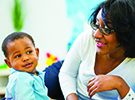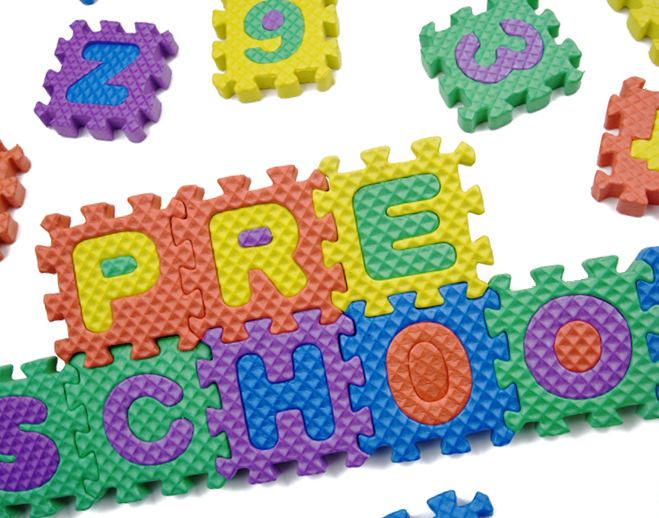Playtime: Big/Little
Lesson for:
Infants
Content Area:
Data Analysis and Probability
Geometry
Routine:
Indoor Play

Playtime: Big/Little
Lesson plan for infants 0 to 6 months
Step 1: Review developmental stage: 0 to 6 months.
Play: Infants begin by using their eyes to explore toys and then begin to use their hands and mouths to explore. Their play is primarily shaking, banging and mouthing. At the end of this stage, they begin to look for dropped toys and may find a partially hidden object.
Communication: Young infants recognize their parents and familiar caregivers. They smile and laugh during playful interactions such as peek-a-boo. They make early cooing and babbling sounds.
Motor: When placed on their tummies, infants learn to hold up their heads and reach for toys. They begin to reach and grasp for objects, beginning with the caregivers’ clothes and hair and then moving on to toys and objects. At the end of this stage, many infants may help hold their own bottles and help bring the bottles to their mouths. They may also begin to take pureed food from a spoon.
Step 2: Gather materials.
- Two balls (one small and one big)
Note: Small parts pose a choking hazard and are not appropriate for children age five or under. Be sure to choose lesson materials that meet safety requirements.
Step 3: Engage infant in lesson activities.
Tummy Time: Tummy time is especially important for the development of motor skills, especially since the advent of the “back to sleep” campaign. Infants need entertainment during tummy time. Place the infant on the floor on his/her tummy. Show the infant the BIG ball. Say: “BIG ball.” Roll the BIG ball slowly away from the infant and point to it rolling away. Say: “The BIG ball is rolling away.” Be sure to capture the infant’s attention so that the infant can track the BIG ball with his/her eyes as it moves away. Show the infant the LITTLE ball. Say: “LITTLE ball.” Roll the LITTLE slowly away from the infant and point to it rolling away. Say: “The LITTLE ball is rolling away.” Be sure to capture the infant’s attention so that the infant can track the LITTLE ball with his/her eyes as it moves away. Continue the game, alternating between the BIG ball and the LITTLE ball for as long as the infant remains engaged in the activity and is happy on his/her tummy.

Playtime: Big/Little
Lesson plan for infants 6 to 12 months
Step 1: Review developmental stage: 6 to 12 months.
Play: At the beginning of this stage, play is mostly shaking, banging and mouthing toys. By the end of this stage, infants begin to combine objects that go together in play. They reach for and hold two objects and may begin to reach for a third. Many infants will look for dropped toys and find partially and completely hidden toys. Many infants enjoy taking objects out of containers and putting them back in.
Communication: At this age, infants respond when their names are called. They may turn their heads, make eye contact and sometimes smile and vocalize. They may look for family members and pets when called by name. They may respond to simple requests made with gestures, such as: “Come here.” They may understand “No” or “Stop.” They may lift their arms to be picked up, clap hands and wave bye-bye. They love to shout and squeal and may be babbling with many different sounds. They may be participating in and sometimes initiating peek-a-boo.
Motor: During this stage, many infants begin to sit by themselves and play. They begin to move by rolling, crawling and cruising. They pick up toys by using a raking motion with their whole hand and, by the end of this stage, they are using their fingers and thumbs to pick up small objects. They may feed themselves small bits of food.
Step 2: Gather materials.
- Two balls (one small and one big)
Note: Small parts pose a choking hazard and are not appropriate for children age five or under. Be sure to choose lesson materials that meet safety requirements.
Step 3: Engage infant in lesson activities.
Playing ball sitting on the floor: Sit across from the infant on the floor. Provide support for the infant to sit if the infant needs it. Show the infant the BIG ball. Say: “BIG ball.” Roll the BIG ball to the infant and point to it rolling towards the infant. Say: “The BIG ball is rolling to (child’s name).” Encourage the infant to reach for and grasp the ball. Balls are easier for infants to grasp at this age if you let a little air out (beach balls work well for this activity). Once the infant has the ball, say: “Roll the BIG ball to (your name).” You may need to help the infant release the BIG ball and push it towards you. Show the infant the LITTLE ball. Say: “LITTLE ball.” Roll the LITTLE ball to the infant and point to it rolling toward the infant. Say: “The LITTLE ball is rolling to (child’s name).” Encourage the infant to reach for and grasp the ball. Once the infant has the ball, say: “Roll the LITTLE ball to (your name).” You may need to help the infant release the LITTLE ball and push it towards you. Continue the game, alternating between the BIG ball and the LITTLE ball for as long as the infant remains engaged in the activity.

Playtime: Big/Little
Lesson plan for infants 12 to 18 months
Step 1: Review developmental stage: 12 to 18 months.
Play: At the beginning of this stage, many infants are imitating the use of everyday objects such as cups and spoons. This moves into early pretend play, when the infant may feed you or pretend to drink from a cup or eat off of an empty spoon. They also are great imitators and may enjoy imitating daily activities. They may enjoy putting multiple objects into containers and systematically searching for hidden toys and objects. Many infants will pat pictures in books and sometimes vocalize while looking at books.
Communication: At the beginning of this stage, many infants begin to respond to one-step directions such as: “Give me the ball.” They may need gestures to help them understand the direction. At the end of this stage, many infants follow a related two-step direction without the help of gestures, such as: “Get the ball and give it to Daddy.” They may be pointing to ask for wants and needs and to ask you to name objects. At around 12 months of age, many infants say one to three words on their own and, by the end of this stage, may say up to 15 words or more. Many infants play turn-taking games at this stage.
Motor: At the beginning of this stage, many infants are crawling and cruising to get around and, by the end of this stage, infants are walking with good balance. They may also enjoy walking while carrying large objects and pulling toys. When given a crayon for the first time, they may mouth the crayon or mark the paper. By the end of this stage, many infants are scribbling on paper. They may be starting to scoop food with a spoon and actually get some to their mouths. Infants may also be using a straw or an open cup to drink.
Step 2: Gather materials.
- Two balls (one small and one big)
Note: Small parts pose a choking hazard and are not appropriate for children age five or under. Be sure to choose lesson materials that meet safety requirements.
Step 3: Engage infant in lesson activities.
Playing ball on the floor: Sit in a circle on the floor with all of the infants in your care that can sit independently and play. Play a turn-taking game rolling balls back and forth with each of the infants. Begin with the BIG ball and roll it to the infant who is showing the most interest. Say: “(Your name) is rolling the BIG ball to (child’s name).” When the infant picks up the BIG ball, say: “(Child’s name), roll the BIG ball.” Talk about where the BIG ball rolls and name whoever picks it up, encouraging the next infant to release and roll the ball. Add the LITTLE ball to the circle, rolling it towards an infant. Continue rolling or encouraging the infants to roll the BIG and LITTLE balls to you and one another, naming the infant who has each ball, requesting that they roll the ball to you or another infant and describing the ball: BIG or LITTLE.

Reflections on this lesson
How might you teach the math lesson BIG and LITTLE during other daily activities and routines?
What books do you have in your child care setting that reinforce the math concept of BIG and LITTLE?
What songs or finger plays do you typically use in your child care setting that reinforce the math concept of BIG and LITTLE?
Comment on this lesson